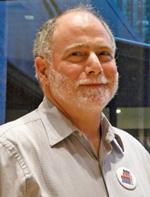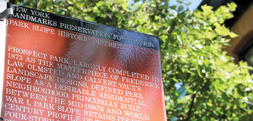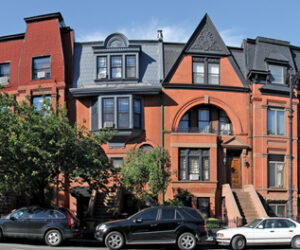 In my 30 years of living in Park Slope, one of the days I will long remember is April 17, 2012 — the day the Landmarks Preservation Commission voted to add more than 600 buildings in the South Slope to the Park Slope Historic District.
In my 30 years of living in Park Slope, one of the days I will long remember is April 17, 2012 — the day the Landmarks Preservation Commission voted to add more than 600 buildings in the South Slope to the Park Slope Historic District.
At the LPC’s public hearing that day, I honestly did not expect much in the way of ceremony, just a routine bureaucratic action. When the item’s turn came on the agenda, the chair would call for a vote, the commissioners would duly respond, a “Resolution Passed” would be pronounced, and then it would be on to the next item.

Even though an affirmative vote on this expansion was never in doubt, I couldn’t have been more surprised and pleased by what actually happened. When discussion at the hearing turned to Park Slope, a map of the South Slope extension was projected behind the 11 commissioners. An LPC staff member recited an executive summary of the proposed action (which can be downloaded from on.nyc.gov/2012-Park-Slope-report). Park Slope looked glorious in the PowerPoint presentation that followed, photographed in early spring with tree blossoms in full bloom.
LPC Chair Robert Tierney then launched a discussion of the South Slope extension by remarking upon the positive relationship between his agency and the Park Slope Civic Council throughout the four-year evaluation process. He then asked each commissioner to comment. Michael Goldblum spoke about having lived on 10th Street for 18 years, and how the new addition forms a “seamless extension” of the original historic district and is “remarkably intact despite its age.” He praised the fact that the area will be protected from the prevalence of “Miracle Whip” buildings rising on Park Slope’s fringes, which lack the materials and craftsmanship that generations have appreciated in Park Slope’s 19th-century homes.
Frederick Bland added, “I have to wonder why the South Slope was not designated in the 1970s,” an idea that triggered a very personal set of reflections. While I spent my childhood years in Indiana, Park Slope was in my roots, as my grandparents and father settled here in the 1920s not long after emigrating from Russia. My grandfather opened a hairdressing business that he operated for decades in the storefront where Carroll Cleaners is now. My earliest memories are of visiting Brooklyn — being awed by its size and mesmerized by the visual splendor of its brownstones. My young eyes — accustomed to the plain white box of a 1950s ranch house — found magic in the tall ceilings crowned by plaster moldings, rich wainscoting, parquet floors, and tiled fireplaces. I wanted to live in a brownstone when I grew up!
The desire to call Park Slope home was not universally shared in the 1950s and ’60s. When I went to college nearby, I became aware of the forces behind the decline of neighborhoods like Park Slope — such as bank redlining, growing automobile use, the exodus of manufacturing to the South, blockbusting tactics, and federal policies favoring suburbs over cities — and began to follow the dynamics of neighborhood change.
Through my close connections to Park Slope, I heard about Everett and Evelyn Ortner: how their activism was changing perceptions of Brownstone Brooklyn and encouraging families to come back to the city. Perhaps their crowning achievement, by virtue of their unrelenting advocacy and research, was to secure the designation of the Park Slope Historic District in July 1973. No other single event so marks the renaissance of Park Slope.
 At that point, I could only appreciate this accomplishment from afar. In 1974, however, I interviewed the Ortners for a term paper on modern architecture. What could be more modern than the new appreciation for 19th-century neighborhoods? It represented my first contact with the Civic Council.
At that point, I could only appreciate this accomplishment from afar. In 1974, however, I interviewed the Ortners for a term paper on modern architecture. What could be more modern than the new appreciation for 19th-century neighborhoods? It represented my first contact with the Civic Council.
Some 20 years later, at a table selling House Tour tickets, I asked then–Civic Council President Terry Ash what it was doing to expand the historic district. She said something that I’ve come to appreciate more in my five years chairing the Historic District Committee — in essence, “If you want to see the historic district expanded, you should volunteer yourself to work on it.”
Fortunately, she referred me to David Alquist, a neighbor who had prodded the Civic Council to move forward with the expansion effort. He was glad to have my help; before I knew it, we formed a committee and recruited many like-minded volunteers. I was aware of the example set by the Ortners and others, who devoted themselves to saving Park Slope from “urban renewal” and the bulldozer. The risk to Park Slope in the 21st century is quite the reverse, however, stemming from the neighborhood’s popularity and city policies that favor development over stability.
At the outset, David and I did not understood much about how to extend landmarking. After walking every block in the neighborhood, we approached the LPC with a request to study a roughly 70-block area. The agency told us to return with a master plan comprising much smaller expansion phases. So began a five-year odyssey — and our constant effort to prod the LPC to action — that culminated with the LPC’s vote in April on the first of three or four more phases, including an upcoming extension in the North Slope. It will be another 10 to 15 years of concerted community organizing until we achieve our goal of preserving the major part of Park Slope’s historically and architecturally significant buildings.
In accepting the Civic Council’s George Lovgren Volunteer Award at the Civic Council’s Annual Meeting in June, I remarked that I am grateful to the Council for offering me an opportunity not only to work on a project I’ve felt passionate about for my entire life but also to be associated with so many other Park Slopers who care so much about their community and are willing to be involved in improving our local quality of life.
Park Slope is and will always be one of the greatest urban neighborhoods in the nation. If you don’t believe me, just ask the American Planning Association, which formally dubbed it so a few years ago. In two decades, our efforts will lead to the Park Slope Historic District reaching its ultimate proportions. Only this action will ensure that it remains one of the truly great places to live in the United States, the largest historic district in New York City, and a place that future generations will appreciate as much as we do.
As the Ortners did for us, this is the legacy that we will leave to them.
— In addition to receiving the Lovgren Award at the Civic Council’s June General Meeting, Historic District Committee Chair Peter Bray was also voted in as a Civic Council trustee.
Photos: Jonathan Lief (Bray) and David Herman (others)
from the Summer 2012 Civic News
Read more about the Historic District in
“A View from the South”

